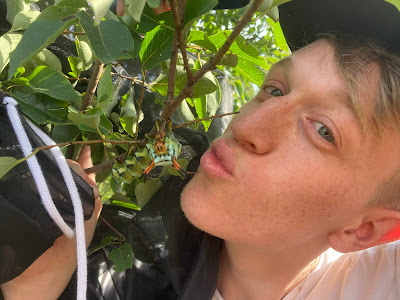This post is about feet, birds, and scary doo-dads.
Someone on Facebook (who may or may not like to sing about gnus) asked "Whatever happened to the Hickory Horned Devil?" which was her subtle way of pointing out that I hadn't posted about it in awhile.
Life gets in the way, is all I have to say, but the Devil kept chugging along. And thank goodness I've already uploaded all my photos, so all I have to do is find time to sit down and write about them!
These photos date from Aug 28-30 when the caterpillar was busy assuming titanic proportions, despite periodic rain.
It was also producing huge frass pellets, in bulk. I shook them out of the sleeve every time I came to photograph the beast.
These are rain-swollen, but still!
Every once in awhile it's good to put your hand in the photo to show the thing's actual size.
The rarely seen frontal view of the real head and face--unassuming, caterpillary, unlike the "face" it presents to predators.
I've turned this photo right-side up, for the Alice-in-Wonderland hookah effect. HHD's spend their days hanging upside down along twigs, where they are practically impossible to see.
This, then, is the typical pose. Even though you're looking right at it, the cream and black bands along its velvety sides break up the form so you can barely see it amidst the sunlit leaves, and the countershaded pale back further flattens the form and makes it disappear. Its first and best defense is camouflage!
I am fascinated by its feet, which have Velcro-like surfaces and stick unbelievably well to branches, and to each other. There is so much to be learned from invertebrate architecture. See, this thing is so heavy and vulnerable that falling out of a tall tree could mean rupture and certain death. Not to mention giving it the uncertain job of finding the right tree to laboriously climb again...So it moves very, very slowly and makes sure it has a deathgrip with some part of its body before it makes a move.
The hind section, shown here in closeup. It reminds me very much of a potholder. My aging brain spat out "Gripperdoodle" when I was trying to describe it, and Gripperdoodle it remained. Maybe entomologists have a better name, but probably not. Oh right. Modified anal prolegs. That thing is like a vise off the back of the big worm.
I'm not sure what the roughened pads on the three sides of the gripperdoodle are all about. Well, maybe that is keratin, to strengthen the structure. Yeah. You can't have an effective gripper if it's squishy! They feel like hard plastic, like a weatherproof car floormat.
Eatin' in the rain. Just eatin' in the rain...
The caterpillar's false face on Sept. 1. The actual head is the shiny orange beanie atop the devil's "head." I just love this view. But why be so ornate, so prongy, so freaky?
Titmice and chickadees, that's why. They don't mind taking their food in oversized packages. I'll never forget seeing this Carolina chickadee rip into a silken cocoon in the Chute on our land and pull out a huge pupa. I don't know if my from-memory rendering of the pupa will suffice for ID (it looks pretty bad), but I suspect this would have been a luna, given that the cocoon was in a tree and not underground. It sure isn't going to be a luna moth now.
From my book,
The Bluebird Effect: Uncommon Bonds with Common Birds.
I will borrow here from a Facebook post by Cynthia Mullens on the Mountain State Birders page. This young tufted titmouse has found a most unfortunate imperial moth caterpillar and is pecking away at it.
The green goo indicates that the enterprising titmouse has scored on the caterpillar and will probably end up eating it. Even if it judges the beast too big to grapple with, the caterpillar is done for. Imperial moth caterpillars are big and impressive, but they have nothing by way of defense--no stinging hairs, no pokey horns, no false eyes or scary faces.
photo by Cynthia Mullens, used by permission
The HHD has that all covered.
There's a lot of bird food in that sea-green tube, but there are also spines, and they're concentrated at the head end.
Any bird that comes at this beast from behind gets a dose of
BLAAA BOOGA BOOGA
which is plenty enough to scare a pecking titmouse or chickadee away. Cuckoos and jays, I suspect, are unfazed by such things, or by lusty thrashing, which is why sleeving the branch was the way to go. The thing I was even more afraid of was parasitic wasps and flies, so a fine mesh sleeve just made sense any way I looked at it. It took the worry out of watching this marvelous being develop.
Knowing the HHD could hang in peace, and that it would be there the next time I came calling, meant the world to me, and gave me peace of mind.




















































Wednesday, October 26, 2022
5 comments